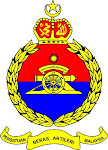Me in front of the War Memorial
I was in Canberra Australia, early
April 2012. I took the opportunity to visit the world class War Memorial. The
War Memorial was so interesting that I had to spend two whole days browsing the
memorials.
I was delighted that a special
section in the Memorial was dedicated to the Battle of Long Tan, Vietnam. The
presentation was really superb and really moving. I had first discussed the
Battle of Long Tan during our artillery courses in the School of Artillery,
Manly. The Battle of Long Tan is one of the classic battle studies in the
Australian Army. Every officer should take a look at this battle. I recommend
every Gunner officer to at least read the book on the battle. Note the artillery support during the battle. You can read the full battle in detail at the websites below.
The fallen soldier
The Battle
The Battle of Long Tan was fought
between the Australian Army and Viet Cong forces in a rubber plantation near
the village of Long Tan, about twenty seven kilometres north east of Vung Tau,
South Vietnam on 18 August 1966. It is arguably the most famous battle fought
by the Australian Army during the Vietnam War.
The action occurred when D
Company of the 6th Battalion, Royal Australian Regiment (6RAR), part of the 1st
Australian Task Force (1 ATF), encountered the Viet Cong (VC) 275 Regiment and
elements of the D445 Local Forces Battalion. D Company was supported by other
Australian units, as well as New Zealand and United States personnel.
The
battle is often used in Australian officer training as an example of the
importance of combining and coordinating infantry, artillery, armour and
military aviation.
For 3-1/2 hours on 18th August,
1966, the 108 men of D Company, 6th Royal Australian Regiment (6RAR) faced over
2,500 Viet Cong and North Vietnamese troops in a rubber plantation at Long Tan.
During this action, they first endured sweltering conditions and then tropical
monsoonal rainfall. At the end of the battle, there were 18 Australian soldiers
killed and 21 wounded. The North Vietnamese Army and Viet Cong lost up to 800
killed and more than 1,000 wounded.
Captain Maurie Stanley had been commanding the 18 guns at Nui Dat, continuously, for
over an hour, and he was calling them in close. The 18 guns were firing over 6
round per minute. You do the maths. the artillery falling between 11 Platoon
and the enemy was the only thing keeping them alive. And the conditions weren't
helping anyone. Lightning struck twice, the first time knocking out telephone
communications and rendering the telephone operator unconscious, sending him
backwards 6 to 8 feet off his chair. The second time it hit the latrines,
blowing them to pieces. At that point you know things have really turned bad!
If Maurie Stanley dropped
the artillery any closer it would be on top of them. It didn't matter, They
just kept coming through, climbing over their own dead and wounded to get to
the Australians.
Four
artillery batteries from 1 Field Regiment at Nui Dat were used in the battle
o 6 x M101A1 105mm L1A1 guns of 161 Field Battery,
Royal New Zealand Army
o 6 x M101A1 105mm guns of 103 Field Battery, Royal
Australian Army
o 6 x M101A1 105mm guns of 105 Field Battery, Royal
Australian Army
o 6 x M109 Self Propelled 155mm guns of A Battery, 2/35th Howitzer Battalion, US Arm
Artillery
at Nui Dat fired almost non-stop for 5 hours in support of the battle
o Regimental Fire Missions (involving all 18 Australian
& NZ artillery guns firing at once and at some stages all six of the US
guns as well) had not been fired since the Korean war and will probably never
be fired again
o Lightning twice hit the artillery positions
o Two artillery gunners passed out from cordite fumes
from the guns as the fumes could not disperse due to the weather
o Artillery fire was eventually being brought in
“Danger Close” to within 50 metres of the Australian positions
Total
Australian and enemy casualties as a result of the Battle of Long Tan
o Australian
0 18 killed (17 from D Coy, 6RAR and 1 from 3Trp, 1APC
Squadron)
0 21 wounded
o NVA and VC1
0 Up to 800 killed (245 bodies counted on the battlefield +
bodies found over two weeks after the battle + identification from the VC
Commanders diary which was captured by US Army)
0 More than 1,000 wounded (Again identified from captured
documents)
0 2 wounded NVA soldiers were captured on the battlefield
0 1 wounded VC soldier was captured on the battlefield
· Total
number of forces opposing each other on the battlefield at Long Tan
o Australia & New Zealand
0 105 soldiers from D Coy, 6RAR, Australian Army
0 3 man New Zealand Forward Artillery Observation party, 161
Bty RNZA
Weapons
and ammunition
o Approximately 400,000 rounds of ammunition were fired
by both sides
o The artillery at Nui Dat fired in excess of 3,500
rounds
o More than 20 rounds of enemy mortar rounds were
dropped on or near D Coy units during the battle
o The Australians captured more than –
0 60+ enemy weapons
0 10,500+ rounds of ammunition
0 300+ hand grenades
0 100+ rounds of rockets and mortars
The above extracts were taken from the websites below:




